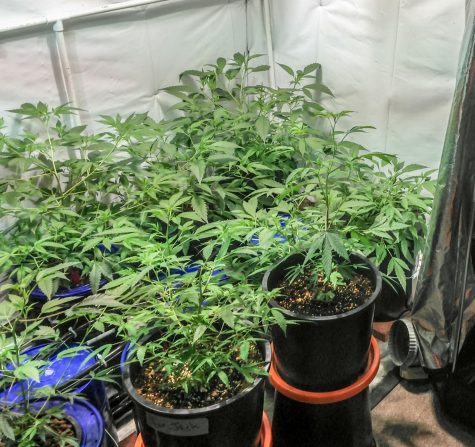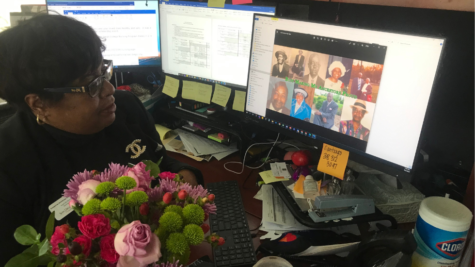The Green Rush
“There’s a different type of bud for each symptom a patient might be facing,” Spring 2016.
January 16, 2018
Spring 2016 Issue:
The smell is intoxicating from the moment you enter the house. Through a room lined with plastic, a light bright as day shines from inside and as you pull the curtains apart, a sea of green plants as high as six feet is revealed. A potential solution to financial instability could lie in a magical crop that has been vilified for more than 50 years by conservatives and pro drug war activists: marijuana.
In 2014, Colorado became the second state to fully legalize the use of marijuana for recreational sale and use. Data released by the Colorado State Department of Revenue reveals that tax revenue from retail marijuana sales amounted to $40.9 million between January 2014 and October 2014. These numbers do not include the sales of marijuana for medicinal use or the fees for licensing. The potential for full legalization is on the horizon with the November 2016 ballot in California.
According to former City College student and local grower Tim*, being in the weed business requires “a hustler’s mentality.” Tim began selling marijuana in the late 90s but being able to grow legally has opened a whole new avenue for him. Asked how much marijuana could be cultivated in one harvest, Tim said it depends: “Anywhere from one to three pounds, but things always happen to your shit. Things that I, being new to it, wasn’t prepared for.” Insects, dry weather conditions, and general bad luck can have major adverse effects on any given crop. But, says Tim,“if all goes well and your harvest gets you that yield of two to three pounds of quality buds, you’re golden.”

People all over California are building rooms like
this one in their homes to grow legal marijuana, Spring 2016
Growing marijuana has become a common practice by many Californians already and full legalization could put even more dollars into many pockets. If a state-issued medical marijuana card is obtained from a licensed physician, San Diego Municipal Code allows for possession of up to one pound of marijuana and 24 plants may be grown in a 64-square-foot indoor room. Unsupervised outdoor cultivation is not permitted. Growing marijuana outdoors is only permissible in an enclosed yard with a minimum six-foot fence perimeter, or it must be in a locked structure such as a greenhouse.
Originally from Ocean Beach, San Diego, 28-year-old Liz* got her start by quitting waitressing and traveling up to what is known as the “Green Triangle” in northern California to trim weed for marijuana growers. She now oversees multiple growing operations. “One pound of marijuana, depending on demand and quality of product, will sell anywhere from $1,800 to $3,800. Selling smaller amounts of weed is the best way to make your money though,” says Liz. “If a pound of ‘chronic’ is sold in increments of grams, which cost around $10 to $15 each, upwards of $4,500 can be made. The price goes down at around a quarter ounce, but not by much. Probably like $60 for a quarter and $120 for a half ounce. $240 for an ounce.”

Studies done by California NORML suggest that retail sales of marijuana could have a total economic impact of $12 to $18 billion including spin off industries, Spring 2016
In order to sell this marijuana legally, according to San Diego Municipal Code, a non-profit mutual benefit corporation that acts as a delivery service can be started. Instead of putting a price on the product, customers are encouraged to make donations of specific amounts. It is a much cheaper option than starting a medical marijuana dispensary and there are fewer hoops to jump through due to the city’s ordinance for pot dispensaries not mentioning delivery services. Perhaps due to this oversight, authorities have kept their focus on regulating the storefront dispensaries over delivery services. Prior to setting up any weed business, consulting a marijuana lawyer is a necessity.
The next step, according to former dispensary owner Steve* is, “You need to establish a clientele and get different weeds to offer. Find reliable sources of different strains of herb.” From Blue Dream to Green Crack, there are all different kinds of buds that people want to try. “Each patient has a need and it’s your job to fill that need. There’s a different type of bud for each symptom a patient might be facing. If they have trouble sleeping you would offer an Indica bud to relax them. If they are a functional smoker, you might offer them a sativa or a hybrid of sorts. One way to remember the difference is, ‘Indica means in the couch.’”
An overview of statistics foreshadows how full legalization might work in California. In Colorado, the stats seem to spin a positive story. According to data from the Colorado Court System, marijuana possession arrests have dropped 84% since 2010. Numbers released by the city of Denver state violent crime and property crime in Denver decreased 2.2% in 2014. In the same period, burglaries in Denver decreased by 9.5% and overall property crime decreased by 8.9%. Furthermore, traffic fatalities went down in 2014, according to data released by the Colorado Department of Transportation, which would challenge any claims that the legalization of marijuana would lead to an increase in traffic fatalities. All of these factors have saved the state millions in litigation and imprisonment costs, further suggesting the positive benefits of legalization.
Furthermore, studies done by California NORML, an organization dedicated to reforming California’s marijuana laws, suggest that a legally regulated market for marijuana in California could yield the state at least $1.2 billion in tax revenues and reduced law enforcement costs. Total retail sales of marijuana could generate $3 to $5 billion, with a total economic impact of $12 to $18 billion including spin off industries such as coffeehouses, tourism, and industrial hemp.
Some law enforcement officials offer a more negative view, indicating the new laws are outpacing their capabilities to enforce them, such as driving under the influence of marijuana. There’s no reliable way to check to see if a driver is too high to operate their vehicle safely and there’s no safe way to tell if a food product in the car is actually a marijuana edible.
Citizens Against Legalizing Marijuana (CALM) is an all-volunteer political action committee dedicated to defeating any efforts to legalize marijuana in California and other states. This committee is composed of volunteer law enforcement, teachers, parents, business owners, and medical professionals. CALM is currently collecting signatures to get a measure on this year’s ballot called the Safe and Drug-Free Community Act. The act aims to keep marijuana illegal for recreational use, prevent privately owned cultivation sites, ban privately owned dispensaries, raise the legal age for medical marijuana use from 18 to 21, and would impose stricter standards on doctors. CALM argues that the potency of marijuana has escalated to the point that it is causing death and destroying the brains of the youth. Furthermore, they say if the United States continues to allow recreational smoking for the 8% of people who want to get high, or make money off those who do, it will detract from the well being of this society. If the measure is passed, it would present a major hurdle against the full legalization effort.
Though the potential for boosting the economy and creating a legion of entrepreneurs is apparent, it isn’t the only reason to join the green rush. When asked the importance of the legalization movement Steve replied, “Patients come first. It’s all about patients before profit. There are people that really need this medicine and as a delivery service, it’s your job to take care of their needs to ease whatever pain they might be experiencing.”
* Names have been modified













